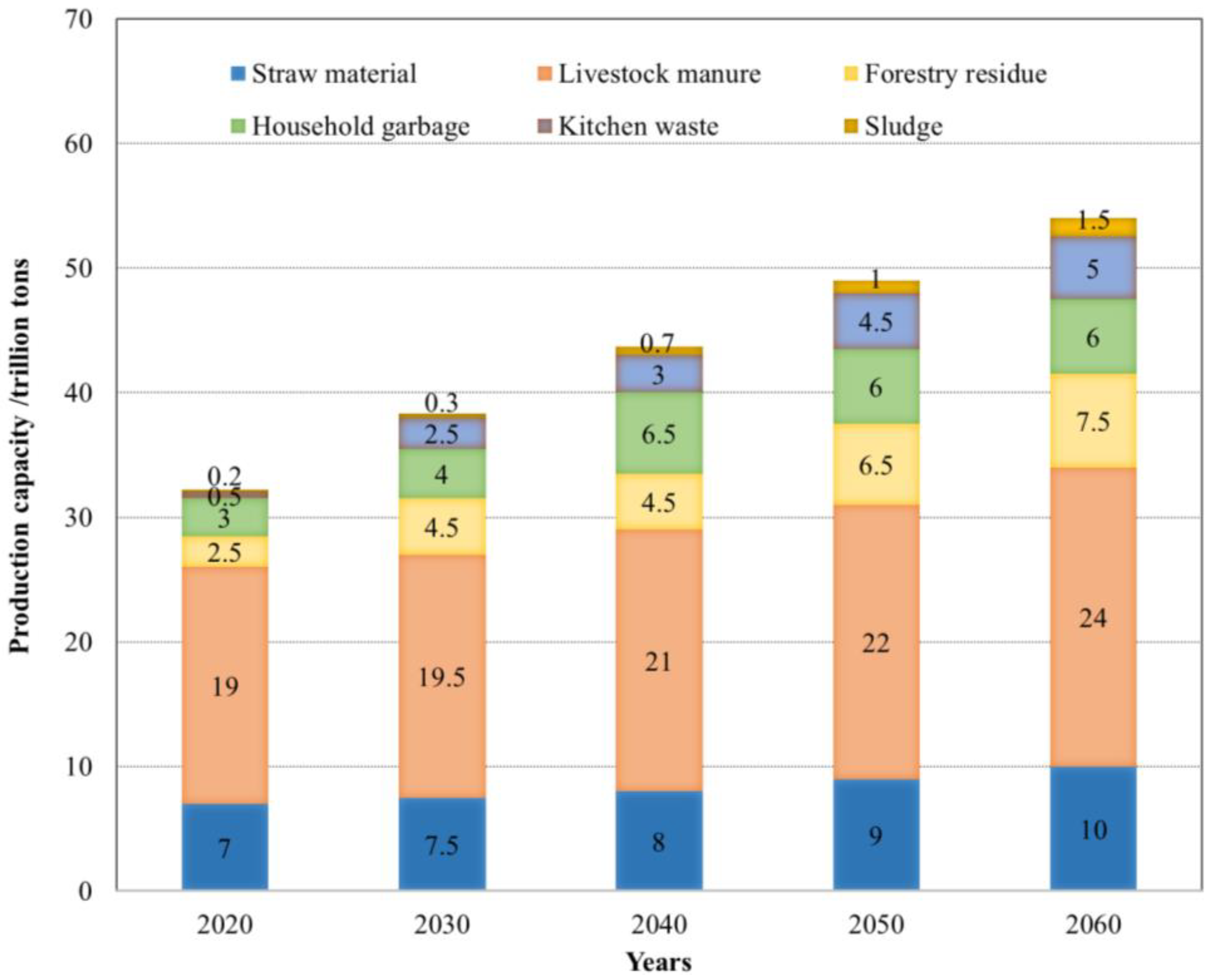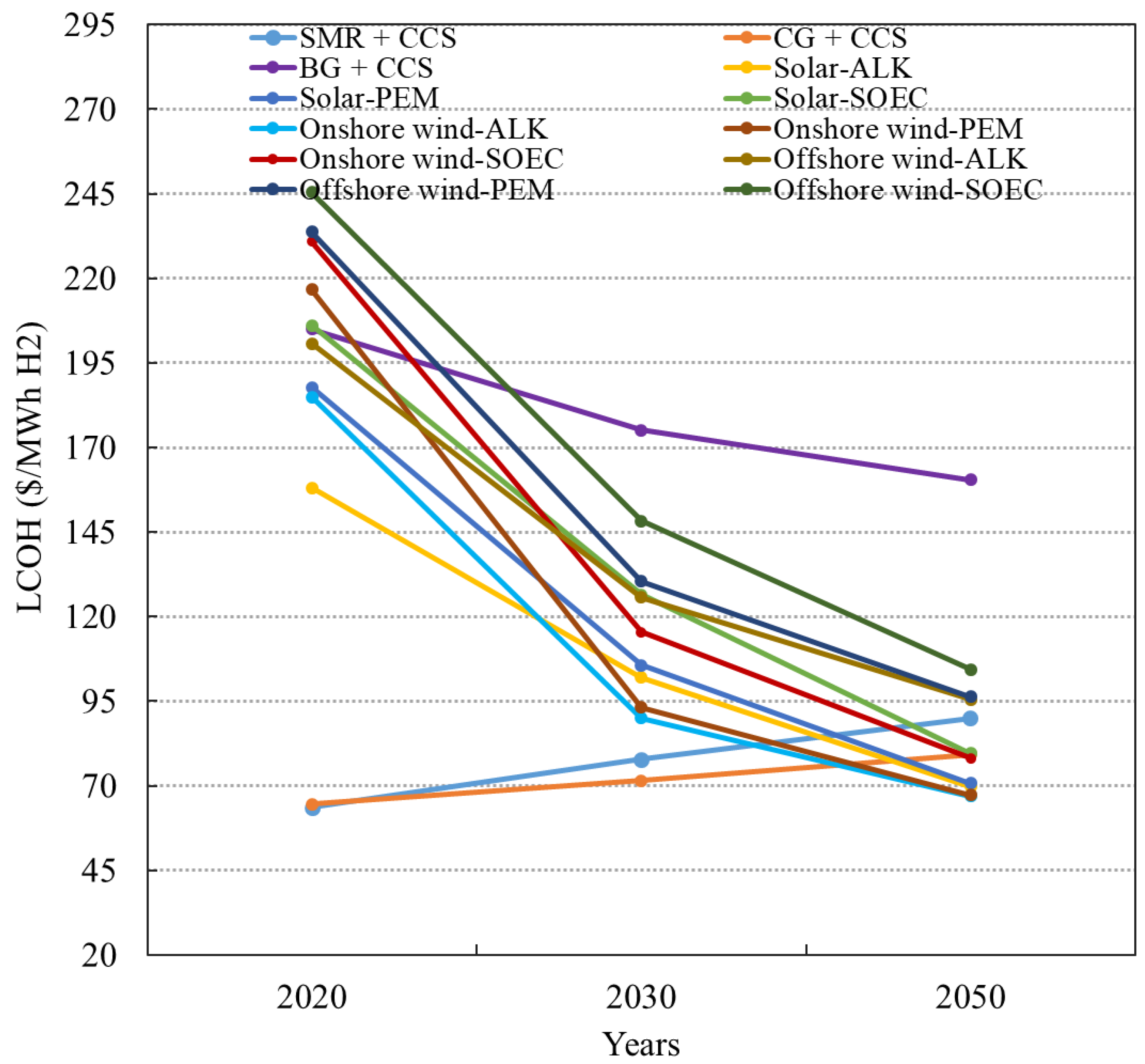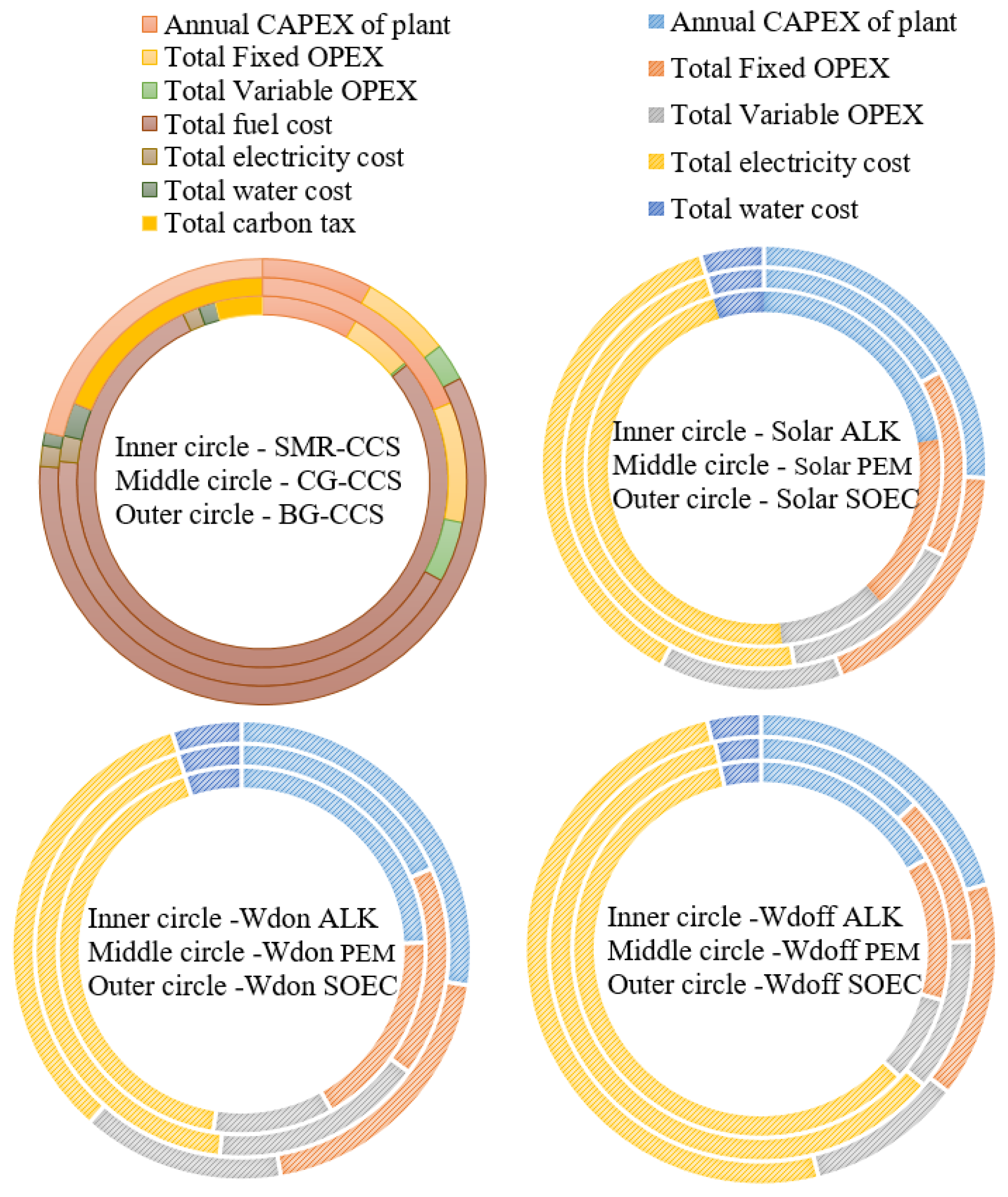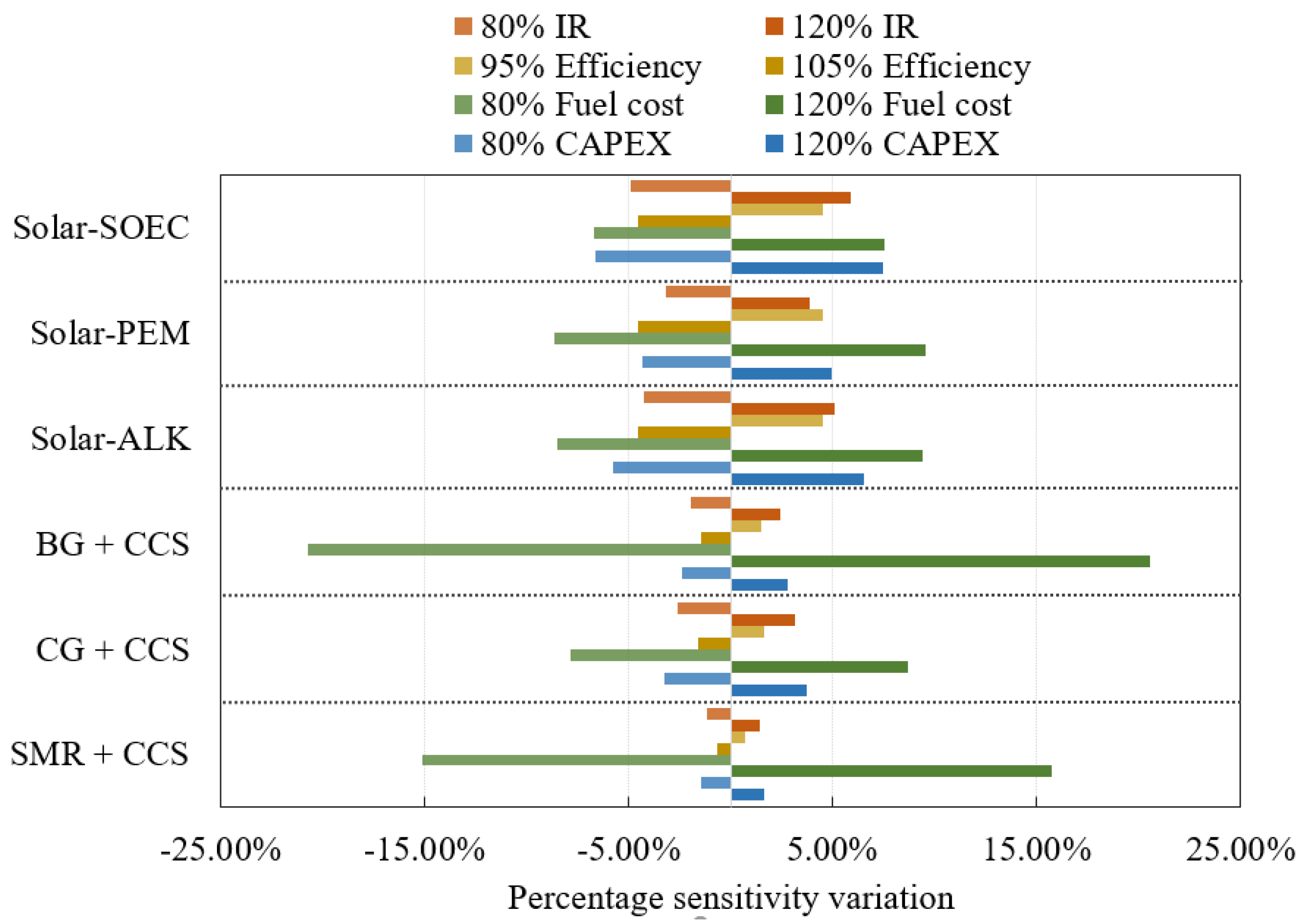Potentials of Mixed-Integer Linear Programming (MILP)-Based Optimization for Low-Carbon Hydrogen Production and Development Pathways in China
Abstract
1. Introduction
1.1. Background
1.2. Literature Review
2. Hydrogen Production for China
2.1. China’s Resources Distribution
2.2. Potential Hydrogen Colors for China
2.2.1. Grey Hydrogen
2.2.2. Blue Hydrogen
2.2.3. Green Hydrogen
3. Methodology and Input Parameters
3.1. Input Parameters
3.2. Methodology
4. Results and Analysis
4.1. The Valuation of Levelized Cost of Hydrogen (LCOH)
4.2. The Cost Components of Hydrogen Production
4.3. The Optimal Technology Mix of Hydrogen Production
4.4. The Sensitivity Analysis of Hydrogen Production
5. Conclusions
Author Contributions
Funding
Data Availability Statement
Conflicts of Interest
References
- Ji, M.; Wang, J. Review and comparison of various hydrogen production methods based on costs and life cycle impact assessment indicators. Int. J. Hydrogen Energy 2021, 46, 38612–38635. [Google Scholar] [CrossRef]
- Ajanovic, A.; Sayer, M.; Haas, R. The economics and the environmental benignity of different colors of hydrogen. Int. J. Hydrogen Energy 2022, 47, 24136–24154. [Google Scholar] [CrossRef]
- IEA. Net Zero by 2050: A Roadmap for the Global Energy Sector; International Energy Agency: Paris, France, 2021; p. 224. [Google Scholar]
- El-Emam, R.S.; Özcan, H. Comprehensive review on the techno-economics of sustainable large-scale clean hydrogen production. J. Clean Prod. 2019, 220, 593–609. [Google Scholar] [CrossRef]
- International Energy Agency. The Future of Hydrogen: Seizing Today’s Opportunities; IEA: Paris, France, 2019; p. 203. [Google Scholar]
- Liu, Z.; Deng, Z.; He, G.; Wang, H.; Zhang, X.; Lin, J.; Qi, Y.; Liang, X. Challenges and opportunities for carbon neutrality in China. Nat. Rev. Earth Environ. 2022, 3, 141–155. [Google Scholar] [CrossRef]
- Yang, Y. Hydrogen, the Keyword for Constructing a Mordern Energy System (in Chinese); National Energy Administration: Beijing, China, 2022. Available online: http://www.nea.gov.cn/2022-05/07/c_1310587396.htm (accessed on 20 January 2023).
- Yates, J.; Daiyan, R.; Patterson, R.; Egan, R.; Amal, R.; Ho-Baille, A.; Chang, N.L. Techno-economic Analysis of Hydrogen Electrolysis from Off-Grid Stand-Alone Photovoltaics Incorporating Uncertainty Analysis. Cell Rep. Phys. Sci. 2020, 1, 100209. [Google Scholar] [CrossRef]
- George, J.F.; Müller, V.P.; Winkler, J.; Ragwitz, M. Is blue hydrogen a bridging technology? -The limits of a CO2 price and the role of state-induced price components for green hydrogen production in Germany. Energy Policy 2022, 167, 113072. [Google Scholar] [CrossRef]
- Hydrogen Council. Path to Hydrogen Competitiveness: A Cost Perspective. 2020. Available online: https://hydrogencouncil.com/wp-content/uploads/2020/01/Path-to-Hydrogen-Competitiveness_Full-Study-1.pdf (accessed on 10 March 2023).
- Burmistrz, P.; Chmielniak, T.; Czepirski, L.; Gazda-Grzywacz, M. Carbon footprint of the hydrogen production process utilizing subbituminous coal and lignite gasification. J. Clean Prod. 2016, 139, 858–865. [Google Scholar] [CrossRef]
- Kim, M.; Kim, J. An integrated decision support model for design and operation of a wind-based hydrogen supply system. Int. J. Hydrog. Energy 2017, 42, 3899–3915. [Google Scholar] [CrossRef]
- Song, S.; Lin, H.; Sherman, P.; Yang, X.; Nielsen, C.P.; Chen, X.; McElroy, M.B. Production of hydrogen from offshore wind in China and cost-competitive supply to Japan. Nat. Commun. 2021, 12, 10–17. [Google Scholar] [CrossRef]
- Yang, X.; Nielsen, C.P.; Song, S.; McElroy, M.B. Breaking the hard-to-abate bottleneck in China’s path to carbon neutrality with clean hydrogen. Nat. Energy 2022, 7, 955–965. [Google Scholar] [CrossRef]
- Yue, M.; Lambert, H.; Pahon, E.; Roche, R.; Jemei, S.; Hissel, D. Hydrogen energy systems: A critical review of technologies, applications, trends and challenges. Renew Sustain. Energy Rev. 2021, 146, 111180. [Google Scholar] [CrossRef]
- IEA. Oil, Gas and Coal Reserves and Resources in China; IEA: Paris, France, 2022; Available online: https://www.iea.org/data-and-statistics/charts/oil-gas-and-coal-reserves-and-resources-in-china (accessed on 10 March 2023).
- IRENA. Future of Wind: Deployment, Investment, Technology, Grid Integration and Socio-Economic Aspects. 2019. Available online: https://www.irena.org/-/media/files/irena/agency/publication/2019/oct/irena_future_of_wind_2019.pdf (accessed on 1 March 2023).
- Li, P.; Yu, H.; Zhang, J.; Du, M.; Xiong, J. Coal Supply Sustainability in China: A New Comprehensive Evaluation Methodology. Front. Energy Res. 2021, 9, 1–19. [Google Scholar] [CrossRef]
- Administration, N.E. Grid-Connected Operation of PV Power Generation in the 1st Half of 2020. Available online: http://www.nea.gov.cn/2020-07/31/c_139254346.htm (accessed on 20 March 2023). (In Chinese)
- IEA. World Energy Outlook 2021. Available online: https://www.iea.org/reports/world-energy-outlook-2021 (accessed on 1 March 2023).
- Asmelash, E.; Prakash, G.; Kadir, M. Wind and Solar PV–What We Need by 2050. Available online: https://www.irena.org/-/media/Files/IRENA/Agency/Webinars/07012020_INSIGHTS_webinar_Wind-and-Solar.pdf? (accessed on 1 May 2023).
- The Installed Capacity of Grid-Connected Wind Power in China; National Energy Administration: Beijing, China, 2021.
- Zhang, S.J.; Jing, W.; Chen, X.; Zhao, Y.H. China in global wind power development: Role, status and impact. Renew. Sustain. Energy Rev. 2020, 127, 109881. [Google Scholar] [CrossRef]
- Binder, M.; Kraussler, M.; Kuba, M.; Luisser, M. Hydrogen from Biomass Gasification; IEA Bioenergy: Paris, France, 2018; Available online: https://task33.ieabioenergy.com/wp-content/uploads/sites/33/2022/07/Wasserstoffstudie_IEA-final.pdf (accessed on 10 January 2023).
- Zhang, D.; Liu, H.; Wang, Y. 3060 Blue Book on Development Potential of Zero Carbon Biomass Energy. 2021. Available online: https://www.xdyanbao.com/doc/xg5ohtm23x?bd_vid=17514962402993766590 (accessed on 15 January 2023). (In Chinese).
- Midilli, A.; Kucuk, H.; Topal, M.E.; Akbulut, U.; Dincer, I. A comprehensive review on hydrogen production from coal gasification: Challenges and Opportunities. Int. J. Hydrogen Energy 2021, 46, 25385–25412. [Google Scholar] [CrossRef]
- Mehmeti, A.; Angelis-Dimakis, A.; Arampatzis, G.; McPhail, S.J.; Ulgiati, S. Life cycle assessment and water footprint of hydrogen production methods: From conventional to emerging technologies. Environments 2018, 5, 24. [Google Scholar] [CrossRef]
- Li, G.; Zhang, K.; Yang, B.; Liu, F.; Weng, Y.; Liu, Z.; Fang, Y. Life cycle analysis of a coal to hydrogen process based on ash agglomerating fluidized bed gasification. Energy 2019, 174, 638–646. [Google Scholar] [CrossRef]
- Yu, M.; Wang, K.; Vredenburg, H. Insights into low-carbon hydrogen production methods: Green, blue and aqua hydrogen. Int. J. Hydrogen Energy 2021, 41, 21261–21273. [Google Scholar] [CrossRef]
- Al-Qahtani, A.; Parkinson, B.; Hellgardt, K.; Shah, N.; Guillen-Gosalbez, G. Uncovering the true cost of hydrogen production routes using life cycle monetisation. Appl. Energy 2021, 281, 115958. [Google Scholar] [CrossRef]
- Guan, Y.; Luo, S.; Liu, S.; Xiao, B.; Cai, L. Steam catalytic gasification of municipal solid waste for producing tar-free fuel gas. Int. J. Hydrogen Energy 2009, 34, 9341–9346. [Google Scholar] [CrossRef]
- Munir, M.T.; Mardon, I.; Al-Zuhair, S.; Shawabkeh, A.; Saqib, N.U. Plasma gasification of municipal solid waste for waste-to-value processing. Renew Sustain. Energy Rev. 2019, 116, 109461. [Google Scholar] [CrossRef]
- Reddy, S.N.; Nanda, S.; Dalai, A.K.; Kozinski, J.A. Supercritical water gasification of biomass for hydrogen production. Int. J. Hydrogen Energy 2014, 39, 6912–6926. [Google Scholar] [CrossRef]
- Schmidt, O.; Gambhir, A.; Staffell, I.; Hawkes, A.; Nelson, J.; Few, S. Future cost and performance of water electrolysis: An expert elicitation study. Int. J. Hydrogen Energy 2017, 42, 30470–30492. [Google Scholar] [CrossRef]
- Department for Business, Energy & Industrial Strategy. Hydrogen Production Costs 2021. Available online: https://assets.publishing.service.gov.uk/media/611b710e8fa8f53dc994e59d/Hydrogen_Production_Costs_2021.pdf (accessed on 1 March 2023).
- Simoes, S.G.; Catarino, J.; Picado, A.; Lopes, T.F.; di Berardino, S.; Amorim, F.; Gírio, F.; Rangel, C.; de Leão, T.P. Water availability and water usage solutions for electrolysis in hydrogen production. J. Clean Prod. 2021, 315, 128124. [Google Scholar] [CrossRef]
- Li, H.; Huang, X.; Zhou, D.; Cao, A.; Su, M.; Wang, Y.; Guo, L. Forecasting Carbon Price in China: A Multimodel Comparison. Int. J. Environ. Res. Public Health 2022, 19, 6217. [Google Scholar] [CrossRef] [PubMed]
- Kaplan, R.; Kopacz, M. Economic conditions for developing hydrogen production based on coal gasification with carbon capture and storage in Poland. Energies 2020, 13, 5074. [Google Scholar] [CrossRef]
- Nasser, M.; Megahed, T.F.; Ookawara, S.; Hassan, H. A review of water electrolysis–based systems for hydrogen production using hybrid/solar/wind energy systems. Environ. Sci Pollut. Res. 2022, 29, 86994–87018. [Google Scholar] [CrossRef]
- IEA. Opportunities for Hydrogen Production with CCUS in China n.d.; IEA Bioenergy: Paris, France, 2022. [Google Scholar]
- Junfeng, L.; Wan, Y.H.; Ohi, J.M. Renewable energy development in China: Resource assessment, technology status, and greenhouse gas mitigation potential. Appl. Energy 1997, 56, 381–394. [Google Scholar] [CrossRef]
- Fang, C. The future analysis and prospects of wind power development in China. Res. Approach 2007, 29, 12. [Google Scholar]
- Pöyry. Wholesale Electricity Price Projections for China. 2014. Available online: https://aim.afry.com/download/18.2274a4ff17b29107f856ac9d/1629106621434/AIMRFlyer_China_2020_v100.pdf (accessed on 15 March 2023).
- Li, Z.; Ito, K.; Komiyama, R. Energy Demand and Supply Outlook in China for 2030 and A Northeast Asian Energy Community—The automobile strategy and nuclear power strategy of China. Jpn. Inst Energy Econ. August 2005, 31, 1–31. [Google Scholar]
- Duić, N.; Štefanić, N.; Lulić, Z.; Krajačić, G.; Pukšec, T.; Novosel, T. EU28 Fuel Prices 2015, 2030 and 2050. Heat Roadmap Eur 2050. 2017. Available online: https://heatroadmap.eu/wp-content/uploads/2020/01/HRE4_D6.1-Future-fuel-price-review.pdf (accessed on 15 March 2023).
- Qin, Y.; Wagner, F.; Scovronick, N.; Peng, W.; Yang, J.; Zhu, T.; Smith, J.R.; Mauzerall, D.L. Air quality, health, and climate implications of China’s synthetic natural gas development. Proc. Natl. Acad. Sci. USA 2017, 114, 4887–4892. [Google Scholar] [CrossRef]













| Embodied Inputs | Unit | SMR | SMR + CCS | CG | CG + CCS | BG | BG + CCS | Solar PV | Wind |
|---|---|---|---|---|---|---|---|---|---|
| Fuel | \ | Natural Gas | Natural Gas | Coal | Coal | Biomass | Biomass | Solar energy | Wind energy |
| Fuel consumption | kg | 3.36 | 3.76 | 8.51 | 10.39 | 36.28 | 36.34 | - | - |
| Electricity consumption | kWh | 0.31 | 1.11 | - | 1.36 | - | 3.58 | 54.2 | 54.2 |
| Water consumption | kg | 21.9 | 23.7 | 11.28 | 40.11 | 47.48 | 47.96 | 13.5 | 13.5 |
| CO2 emissions | kg | 9.26 | 1.03 | 20.98 | 4.13 | 32.84 | 16.77 | \ | \ |
| CH4 emissions | kg | \ | \ | 2.66 × 10−2 | 3.22 × 10−2 | \ | \ | \ | \ |
| N2O emissions | kg | \ | \ | 6.97 × 10−6 | 1.87 × 10−5 | \ | \ | \ | \ |
| NO2 emissions | kg | \ | \ | \ | \ | 0.01 | 7.74 × 10−3 | \ | \ |
| [2020, 2030, 2050] | $/kW | \ | [530, 466, 361] | \ | [1200, 900, 750] | \ | [1370, 1250, 1100] | \ | \ |
| Fixed [2020] | $/kW.year | \ | 25.38 | \ | 41.68 | \ | 95 | \ | \ |
| Variable | $/kWh H2 | \ | 0.00013 | \ | 0.0026 | \ | 0.005 | \ | \ |
| Load factor | % | \ | 90% | \ | 90% | \ | 90% | \ | \ |
| Comparison | AEK | PEM | SOEC |
|---|---|---|---|
| Electrolyte | NaOH/KOH(aq) | Polymer(s) | YSZ(s) |
| Charge carriers | OH | H+ | O2− |
| Electrode material | Ni and Ni alloys | Platinum group metals | Cermet and doped metal composites |
| Temperature | 60–90 °C | 50–90 °C | 500–1000 °C |
| Pressure [2020] | 2–10 bar | 15–30 bar | less than 30 bar |
| Cell voltage [2020] | 1.8–2.4 V | 1.8–2.2 V | 0.95–1.3 V |
| Current density [2020] | 0.2–0.5 A/cm2 | 1–2 A/cm2 | 0.3–1 A/cm2 |
| Efficiency [2020] | 62-82% | 67–84% | 81–86% |
| System lifetime | 20-30 years | 10–20 years | \ |
| Hydrogen production (maximum) | 760 Nm3/h | 30 Nm3/h | \ |
| Annual degradation | 2–4% | 2–4% | 17% |
| Electricity consumption kWh/kg H2 [2020, 2030, 2050] | [51, 48, 46] | [55, 50, 47] | [39, 37, 35] |
| Heat energy consumption kWh/kg H2 [2020, 2030, 2050] | \ | \ | [32, 31, 30] |
| £/kW (electricity input) [2020, 2030, 2050] | [600, 500, 455] | [790, 400, 340] | [1600, 1000, 650] |
| Fixed M£/kW.year | 13.6 and replacement | 16.5 and replacement | 19.5 and replacement |
| Variable £/kWh.year | 0.002 | 0.0077 | 0.0085 |
| Load factor | 50% | 50% | 50% |
| Year | 2020 | 2030 | 2050 |
|---|---|---|---|
| H2 demand in China/Mt | 33 | 39.6 | 130 |
| NG price $/MWh | 30.1 | 41.3 | 51.1 |
| Coal price $/MWh | 9.6 | 14 | 16.8 |
| Biomass price $/MWh | 31.2 | 32.9 | 37.9 |
| Water cost 1 $/t | 2 | 2 | 2 |
| Water cost 2 $/t | 8 | 8 | 8 |
| Grid electricity price $/MWh | 80.9 | 52.9 | 46.9 |
| Solar electricity price $/MWh | 83 | 48.8 | 29.3 |
| Onshore wind electricity price $/MWh | 103.7 | 39 | 24.4 |
| Offshore wind electricity price $/MWh | 115.9 | 68.3 | 48.8 |
| CO2 tax $/ton | 49 | 73.2 | 141.5 |
Disclaimer/Publisher’s Note: The statements, opinions and data contained in all publications are solely those of the individual author(s) and contributor(s) and not of MDPI and/or the editor(s). MDPI and/or the editor(s) disclaim responsibility for any injury to people or property resulting from any ideas, methods, instructions or products referred to in the content. |
© 2024 by the authors. Licensee MDPI, Basel, Switzerland. This article is an open access article distributed under the terms and conditions of the Creative Commons Attribution (CC BY) license (https://creativecommons.org/licenses/by/4.0/).
Share and Cite
Mao, J.; Zhang, G.; Ling, Z.; Yuan, D.; Liu, M.; Xu, J. Potentials of Mixed-Integer Linear Programming (MILP)-Based Optimization for Low-Carbon Hydrogen Production and Development Pathways in China. Energies 2024, 17, 1694. https://doi.org/10.3390/en17071694
Mao J, Zhang G, Ling Z, Yuan D, Liu M, Xu J. Potentials of Mixed-Integer Linear Programming (MILP)-Based Optimization for Low-Carbon Hydrogen Production and Development Pathways in China. Energies. 2024; 17(7):1694. https://doi.org/10.3390/en17071694
Chicago/Turabian StyleMao, Jiani, Guangxue Zhang, Zhongqian Ling, Dingkun Yuan, Maosheng Liu, and Jiangrong Xu. 2024. "Potentials of Mixed-Integer Linear Programming (MILP)-Based Optimization for Low-Carbon Hydrogen Production and Development Pathways in China" Energies 17, no. 7: 1694. https://doi.org/10.3390/en17071694
APA StyleMao, J., Zhang, G., Ling, Z., Yuan, D., Liu, M., & Xu, J. (2024). Potentials of Mixed-Integer Linear Programming (MILP)-Based Optimization for Low-Carbon Hydrogen Production and Development Pathways in China. Energies, 17(7), 1694. https://doi.org/10.3390/en17071694







